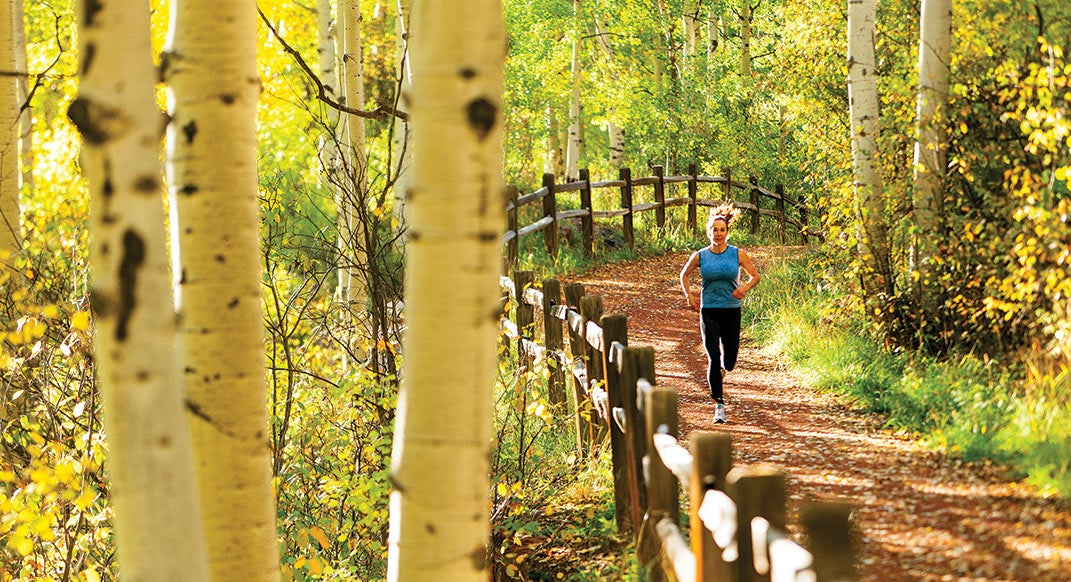Telluride, Colorado: Trail-Running Boom Town

Telluride’s remote location hasn’t kept the mountain town from booming over the years. Explorers of yore first flocked to the region after gold was discovered in 1858. The subsequent mining rush helped Telluride’s population blossom to 5,000 residents—more than double the present-day population—and lured in the likes of Butch Cassidy, who robbed the wealthy San Miguel Valley Bank in 1889. The Wild West town has since been tamed and developed into a thriving ski resort, and boasts an extensive summer festival schedule.
But the no-frills trail-running scene helps keep this year-round outdoor-sports mecca refreshingly low-key. Telluride Mountain Run race director Dakota Jones believes his race captures the essence of trail running in Telluride, saying, “I want it to be one way to express a sense of authenticity in the sport.” Try Telluride’s trail running and experience this boom town’s latest boom.
Trails
San Miguel River Trail / Need a shake-out run on flat terrain with a sweet view? Access this flat, dirt 4.25-mile trail tracing the San Miguel River. You can also use this trail to jump onto longer, steeper routes in almost every direction.
Bridal Veil Falls Road / It may be a dirt road shared with jeeps, but the 1.8 miles and 1,200 feet of gain is certainly worth it to see 365-foot Bridal Veil Falls, the tallest free-falling falls in Colorado. For longer runs to alpine lakes and mines, continue on the Bridal Veil Basin Trail from the top of the falls.
Sneffels Highline Trail / This is a 13-ish-mile loop sporting a stiff 3,800-plus feet of climb. It passes through mining ruins and affords luscious views of wildflowers and aspen trees in the high-elevation backcountry. The altitude and ruggedness make these 13 miles feel more like a long run, so
be prepared.
Races
Hardrock Hundred Mile Endurance Run / The renowned event includes more than 33,000 feet of climb and a high point of 14,048 feet, and salutes the hardrock miners’ toughness and perseverance. Runners circumnavigate the rugged loop course in a clockwise or counter-clockwise direction, depending
on the year, starting from Silverton and passing through Ouray and Telluride.
Telluride Mountain Run / Starting and finishing in downtown Telluride, runners ascend three 12,500-plus-foot passes over 40-ish miles with only three aid stations.
Imogene Pass Run / Taking place in September, this competitive, 17-mile, point-to-point mountain race connects Ouray to Telluride via 13,114-foot Imogene Pass.
Trip Planning
Get There / Fly into Telluride Regional Airport or, for more flight options, Montrose Regional Airport, 67 miles north of Telluride. For the cheapest flight options, fly into Grand Junction, 127 miles north, which is also accessible via Amtrak. Book a rental car or shuttle service from the airport in advance. Arrive by car via the scenic San Juan Skyway (State Highway 145) from Cortez or Naturita.
Play Tourist / Take a free gondola ride, equipped with bike racks during the summer, and mountain bike down trails within the Telluride Ski Resort boundaries. Visit the downtown Telluride Historical Museum. Attend the world-renowned Telluride Bluegrass Festival, which has been held every June since 1973.
Take Note / Plan high-country excursions for late summer to avoid leftover winter snowpack. The San Juan Mountains receive a significant number of lightning strikes from July through September, especially from noon until early evening. Telluride swells with visitors during festival weeks, limiting accommodation options and filling restaurants—plan accordingly.
This article originally appeared in our September 2016 issue.